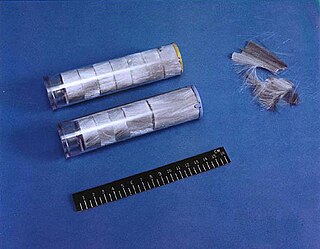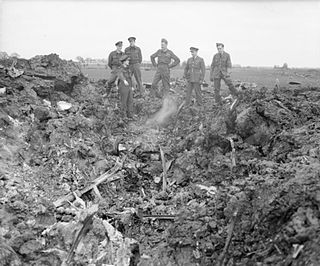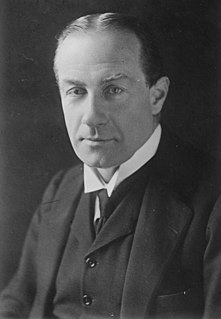
Fighter aircraft are fixed-wing military aircraft designed primarily for air-to-air combat. In military conflict, the role of fighter aircraft is to establish air superiority of the battlespace. Domination of the airspace above a battlefield permits bombers and attack aircraft to engage in tactical and strategic bombing of enemy targets.

A night fighter is a fighter aircraft adapted for use at night or in other times of bad visibility. Night fighters began to be used in World War I and included types that were specifically modified to operate at night.

A surface-to-air missile (SAM), also known as a ground-to-air missile (GTAM) or surface-to-air guided weapon (SAGW), is a missile designed to be launched from the ground to destroy aircraft or other missiles. It is one type of anti-aircraft system; in modern armed forces, missiles have replaced most other forms of dedicated anti-aircraft weapons, with anti-aircraft guns pushed into specialized roles.

Schräge Musik, which may also be spelled Schraege Musik, was a common name for the fitting of an upward-firing autocannon or machine gun, to an interceptor aircraft, such as a night fighter. The term was introduced by the German Luftwaffe during World War II. "Schräge Musik" was previously a German colloquialism, meaning music that featured an unusual tuning and/or time signature. By itself, the word Schräge has often been translated as "slanting" or "oblique", although it may instead be rendered into English as "weird" or "strange".

An electronic countermeasure (ECM) is an electrical or electronic device designed to trick or deceive radar, sonar or other detection systems, like infrared (IR) or lasers. It may be used both offensively and defensively to deny targeting information to an enemy. The system may make many separate targets appear to the enemy, or make the real target appear to disappear or move about randomly. It is used effectively to protect aircraft from guided missiles. Most air forces use ECM to protect their aircraft from attack. It has also been deployed by military ships and recently on some advanced tanks to fool laser/IR guided missiles. It is frequently coupled with stealth advances so that the ECM systems have an easier job. Offensive ECM often takes the form of jamming. Self-protecting (defensive) ECM includes using blip enhancement and jamming of missile terminal homers.

No. 100 Group was a special duties group within RAF Bomber Command. The group was formed on 11 November 1943 to consolidate the increasingly complex business of electronic warfare and countermeasures in one organisation. The group was responsible for the development, operational trial and use of electronic warfare and countermeasures equipment. It was based at RAF stations in East Anglia, chiefly Norfolk.

Ground-controlled interception (GCI) is an air defence tactic whereby one or more radar stations or other observational stations are linked to a command communications centre which guides interceptor aircraft to an airborne target. This tactic was pioneered during World War I by the London Air Defence Area organization, which became the Royal Air Force's Dowding system in World War II, the first national-scale system. The Luftwaffe introduced similar systems during the war, but most other combatants did not suffer the same threat of air attack and did not develop complex systems like these until the Cold War era.

Chaff, originally called Window by the British and Düppel by the Second World War era German Luftwaffe, is a radar countermeasure in which aircraft or other targets spread a cloud of small, thin pieces of aluminium, metallized glass fibre or plastic, which either appears as a cluster of primary targets on radar screens or swamps the screen with multiple returns.

A tail gunner or rear gunner is a crewman on a military aircraft who functions as a gunner defending against enemy fighter or interceptor attacks from the rear, or "tail", of the plane.
Serrate was a World War II Allied radar detection and homing device used by night fighters to track Luftwaffe night fighters equipped with the earlier UHF-band BC and C-1 versions of the Lichtenstein radar. It allowed RAF night fighters to attack their German counterparts, disrupting their attempts to attack the RAF's bomber force.
The Rainbow Codes were a series of code names used to disguise the nature of various British military research projects. They were mainly used by the Ministry of Supply from the end of the Second World War until 1958, when the ministry was broken up and its functions distributed among the forces. The codes were replaced by an alphanumeric code system.
Wing Commander Bransome Arthur "Branse" Burbridge, was a Royal Air Force (RAF) night fighter pilot and flying ace—a pilot credited with at least five enemy aircraft destroyed—who holds the Allied record of 21 aerial victories achieved at night during the Second World War.
Operation Diver was the British codename for countermeasures against the V-1 flying bomb campaign launched by the German Luftwaffe in 1944 against London and other parts of Britain. Diver was the codename for the V-1, against which the defence consisted of anti-aircraft guns, barrage balloons and fighter aircraft. The British Double-Cross System used Double agents to plant false information about the accuracy of the V-1 bombardment. Anti-aircraft guns proved the most effective form of defence in the later stages of the campaign, with the aid of radar-based technology and the proximity fuse. The V-1 campaign from ground launch sites ended by the middle of 1944 with the Allied occupation of the launch sites.

Operation Steinbock, sometimes called the Baby Blitz, was a strategic bombing campaign by the German Air Force during the Second World War. It targeted southern England and lasted from January to May 1944. Steinbock was the last strategic air offensive by the German bomber arm during the conflict.

"The bomber will always get through" was a phrase used by Stanley Baldwin in a 1932 speech "A Fear for the Future" given to the British Parliament. His speech stated that contemporary bomber aircraft had the performance necessary to conduct a strategic bombing campaign that would destroy a country's cities and there was little that could be done in response. It concluded that the conduct of future wars would require one to "kill more women and children more quickly than the enemy if you want to save yourselves."

The Defence of the Reich is the name given to the strategic defensive aerial campaign fought by the Luftwaffe air arm of the combined Wehrmacht armed forces of Nazi Germany over German-occupied Europe and Nazi Germany during World War II. Its aim was to prevent the destruction of German civilians, military and civil industries by the Western Allies. The day and night air battles over Germany during the war involved thousands of aircraft, units and aerial engagements to counter the Allied strategic bombing campaign. The campaign was one of the longest in the history of aerial warfare and with the Battle of the Atlantic and the Allied Blockade of Germany was the longest of the war. The Luftwaffe fighter force defended the airspace of German-occupied territory against attack, first by RAF Bomber Command and then against the United States Army Air Forces (USAAF).
Nachtjagdgeschwader 1 (NJG 1) was a German Luftwaffe night fighter-wing of World War II. NJG 1 was formed on 22 June 1940 and comprised four Gruppen (groups). NJG 1 was created as an air defence unit for the Defence of the Reich campaign; an aerial war waged by the Luftwaffe against the bombing of the German Reich by RAF Bomber Command and the United States Air Force. In 1941 airborne radar was introduced with radar operators, and standardised in 1942 and 1943. Consequently, a large number of German night fighter aces existed within NJG 1.

Operation Gisela was the codename for a German military operation of the Second World War. Gisela was designed as an aerial intruder operation to support the German air defence system in its night battles with RAF Bomber Command during the Defence of the Reich campaign. It was the last major operation launched by the LuftwaffeNachtjagdgeschwader during the conflict.

Radar, Airborne Interception, Mark VIII, or AI Mk. VIII for short, was the first operational microwave-frequency air-to-air radar. It was used by Royal Air Force night fighters from late 1941 until the end of World War II. The basic concept, using a moving parabolic antenna to search for targets and track them accurately, remained in use by most airborne radars well into the 1980s.













